The Samsung 983 ZET (Z-NAND) SSD Review: How Fast Can Flash Memory Get?
by Billy Tallis on February 19, 2019 8:00 AM ESTQD1 Random Read Performance
Drive throughput with a queue depth of one is usually not advertised, but almost every latency or consistency metric reported on a spec sheet is measured at QD1 and usually for 4kB transfers. When the drive only has one command to work on at a time, there's nothing to get in the way of it offering its best-case access latency. Performance at such light loads is absolutely not what most of these drives are made for, but they have to make it through the easy tests before we move on to the more realistic challenges.
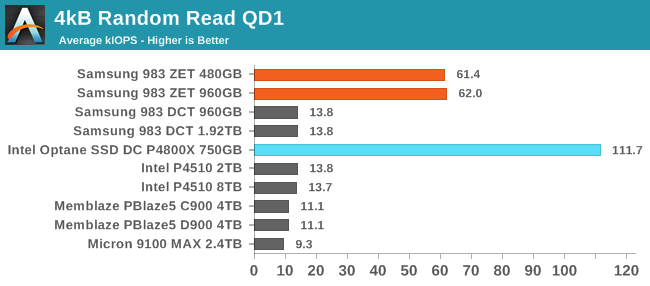
The 983 ZET comes even closer to matching the Optane SSD on our random read power efficiency score. Even in this enterprise configuration, the Samsung Phoenix is still a relatively low-power NVMe SSD controller, and the 983 ZET only draws a bit more power overall than the TLC-based 983 DCT. While the Optane SSD may have delivered almost twice the raw performance, it only has a 15-20% advantage in performance-per-Watt here.
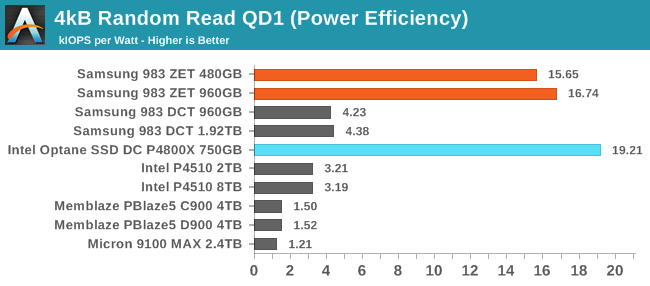 |
|||||||||
| Power Efficiency in kIOPS/W | Average Power in W | ||||||||
The random read latency stats for the 983 ZET clearly set it apart from the rest of the flash-based SSDs and put it in the same league as the Optane SSD. The Optane SSD's average latency of just under 9µs is still better than the 16µs from the 983 ZET, but the tail latencies for the two are quite similar. Both Z-NAND and 3D XPoint provide better 99.99th percentile latency here than the average latencies of the MLC and TLC drives.
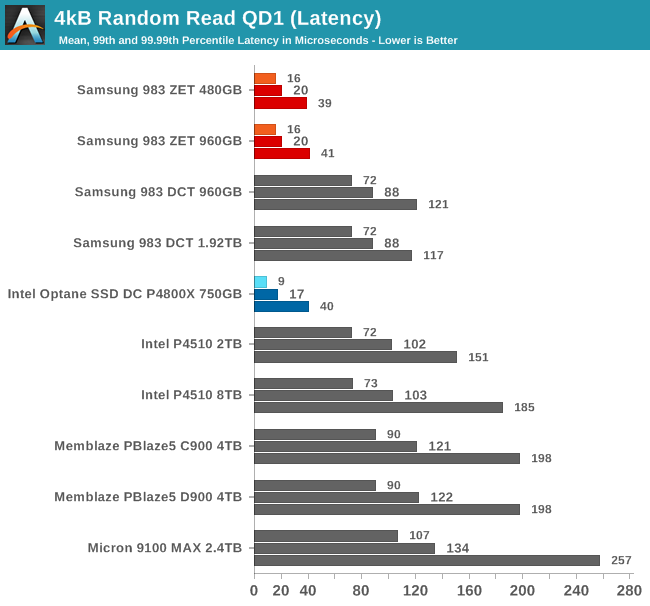
The random read performance of the 983 ZET is clearly optimized specifically for 4kB reads—both smaller and larger transfers take a significant hit to IOPS. By contrast, the Optane SSD's IOPS declines smoothly as the transfer size increases from the minimum of a single 512 byte logical block.
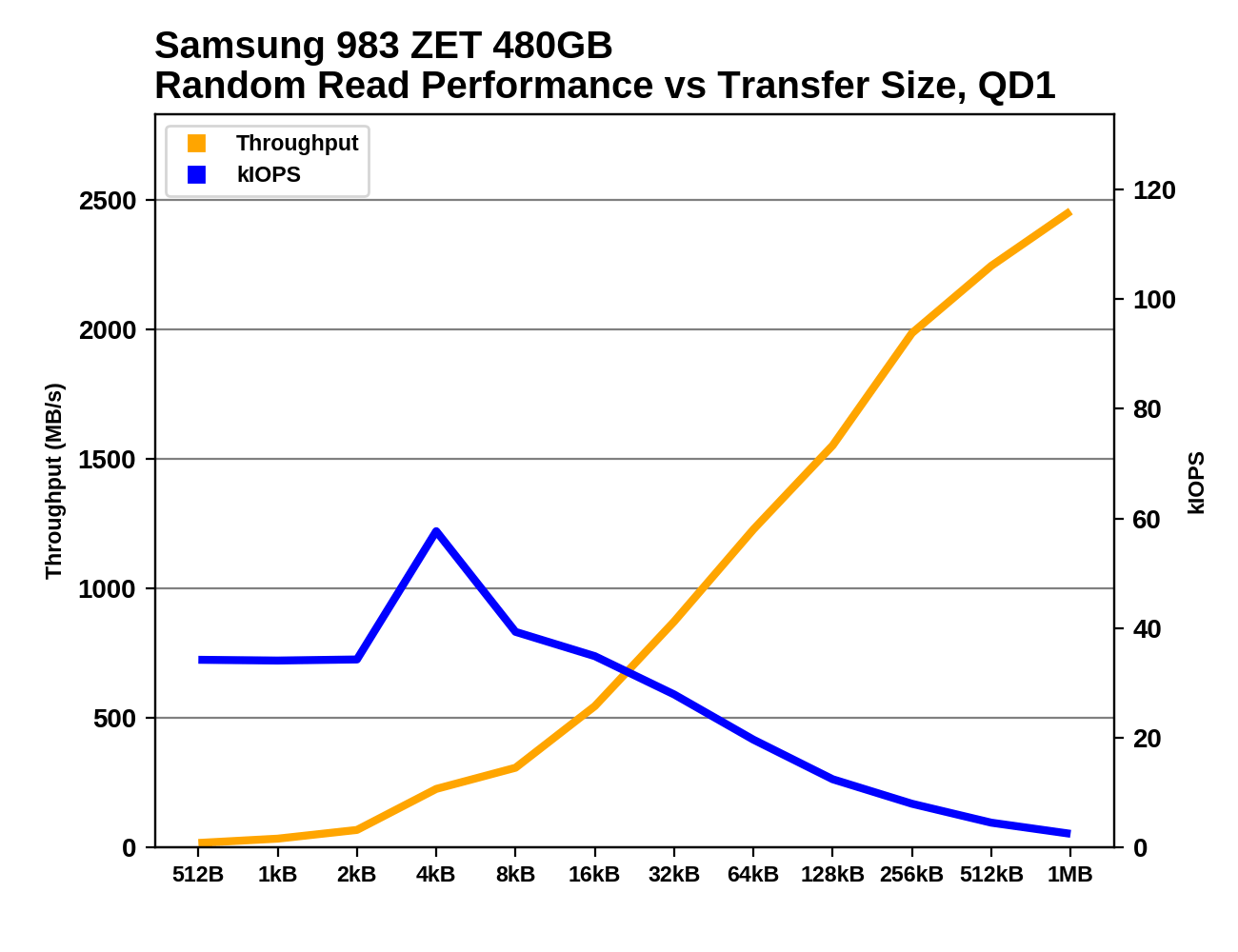 |
|||||||||
The other flash-based SSDs show fairly low throughput until the transfer sizes get up to around 128kB, but the Z-NAND's smaller page size allows it to exercise parallelism even for smaller transfers: the 960GB 983 ZET has higher throughput for 32kB reads than the TLC-based 983 DCT for 128kB reads.
QD1 Random Write Performance
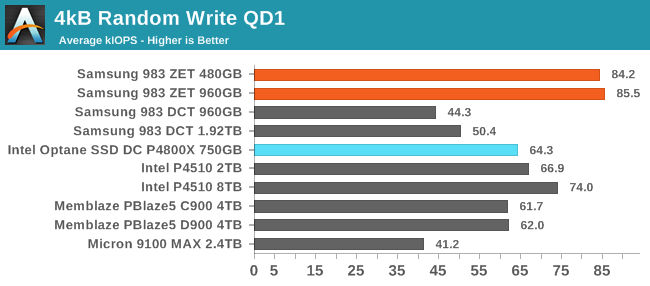
The Samsung 983 ZET takes the lead for QD1 random write performance, and the Intel Optane SSD doesn't stand out from other flash-based SSDs. Intel's 3D XPoint memory has a far faster write latency than the programming times of NAND flash memory (even Z-NAND), but flash-based SSDs are very good at covering this up with DRAM caches. Thanks to their power loss protection capacitors, enterprise SSDs can safely report writes as complete while the data is still in their RAM, and the writes can be deferred and batched in the background. Intel's Optane SSDs do not have any DRAM and instead performs writes directly without the caching layer (and without the large power loss protection capacitors).
 |
|||||||||
| Power Efficiency in kIOPS/W | Average Power in W | ||||||||
The Samsung 983 ZET also provides the best power efficiency during our QD1 random write test, but the Optane SSD and the TLC-based 983 DCT come close. In terms of total power, the Optane SSD draws about the same performing random writes as random reads, but all of the flash-based SSDs require much more power for writes than reads. The Samsung 983 ZET requires significantly more power than the 983 DCT, but not quite as much as the Intel P4510 and the other flash-based SSDs that use larger controllers.
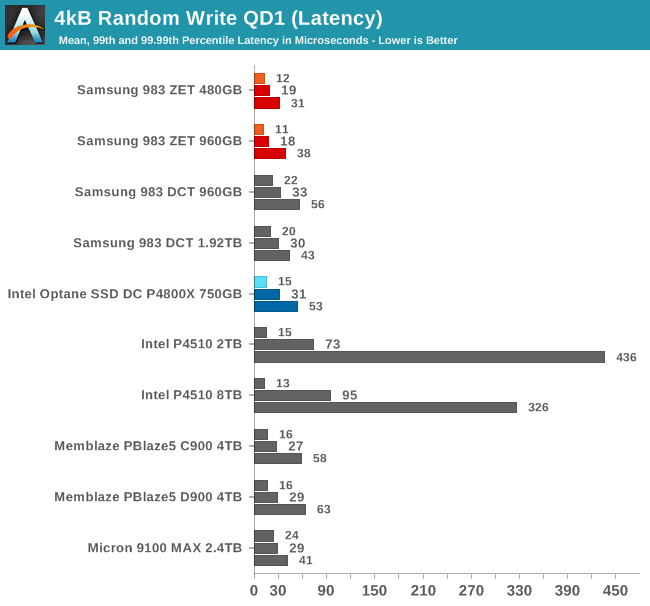
The latency stats for the Samsung 983 ZET performing random writes at QD1 are the best in the bunch, but it doesn't stand out by much. The Intel P4510 has high tail latencies, but the rest of these NVMe drives have 99.99th percentile latencies that are no worse than four times their average latency. At low queue depths, almost all of these drives have no problem with QoS.
 |
|||||||||
The Samsung 983 ZET's optimization for 4kB accesses is again apparent, but the performance for smaller writes is not crippled as it is for the Memblaze PBlaze5 and Micron 9100 MAX. Using transfers larger than 4kB doesn't yield any steady-state random write throughput increases all the way up to writing 1MB blocks, so IOPS falls off quickly as transfer size grows.
QD1 Sequential Read Performance
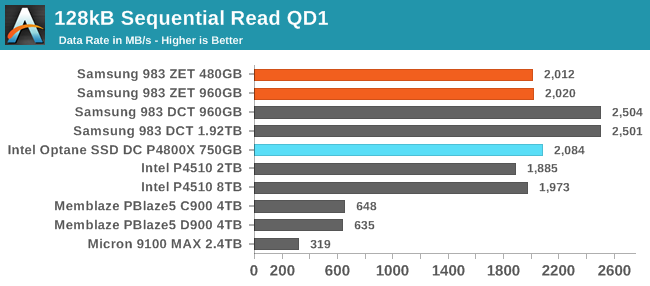
The queue depth 1 sequential read performance of the 983 ZET is lower than the TLC-based 983 DCT: about 2GB/s instead of 2.5GB/s. This puts the 983 ZET more in line with Intel's drives, including the Optane SSD. This is one area where the smaller page size of the Z-NAND is detrimental.
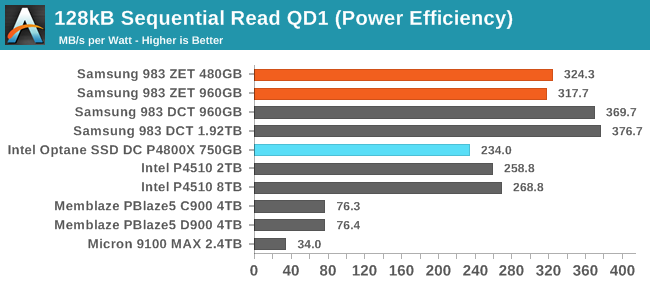 |
|||||||||
| Power Efficiency in MB/s/W | Average Power in W | ||||||||
The 983 ZET draws only slightly less power than the 983 DCT, which combined with its 20% worse performance leads to a lower efficiency score. However, both Samsung drives still provide better performance per Watt than the other drives included here, which all have more power-hungry controllers than the Samsung Phoenix.
 |
|||||||||
The 983 ZET's sequential read speed at QD1 is almost at full speed for block sizes of at least 32kB, but there's a slight improvement at 512kB or larger. The 983 DCT and Intel P4510 top out with 256kB transfers, while the Memblaze PBlaze5 delivers poor read speeds without either a large block size or high queue depth.
QD1 Sequential Write Performance
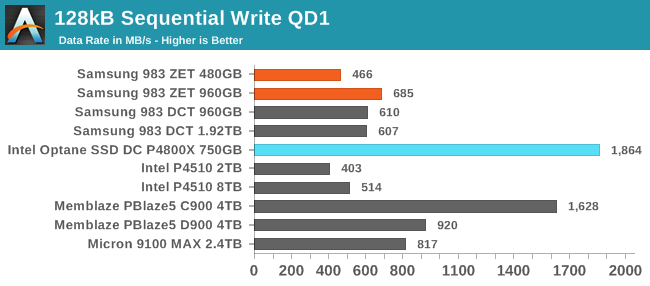
The Samsung 983 ZET excelled at QD1 random writes, but it is hardly any better than the TLC drives for QD1 sequential writes, and the smaller Z-SSD is substantially slower. This is because even at QD1, there's enough data moving to keep the drive at steady state, where the background garbage collection is limited by the slow block erase operations that affect Z-NAND just as much as traditional NAND flash memory. The Optane SSD is almost three times the speed of the larger Z-SSD. It is followed by the PBlaze5 C900, which benefits from a PCIe 3 x8 interface.
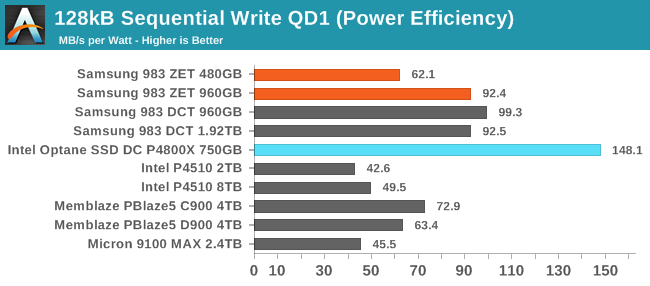 |
|||||||||
| Power Efficiency in MB/s/W | Average Power in W | ||||||||
Both capacities of the 983 ZET use slightly more power during the sequential write test than the 983 DCT, which leaves the smaller Z-SSD with a significantly worse efficiency score. The larger Z-SSD and the two TLC-based 983 DCTs have the best efficiency scores among the flash-based SSDs, but that's still only two thirds the performance per Watt provided by the Optane SSD.
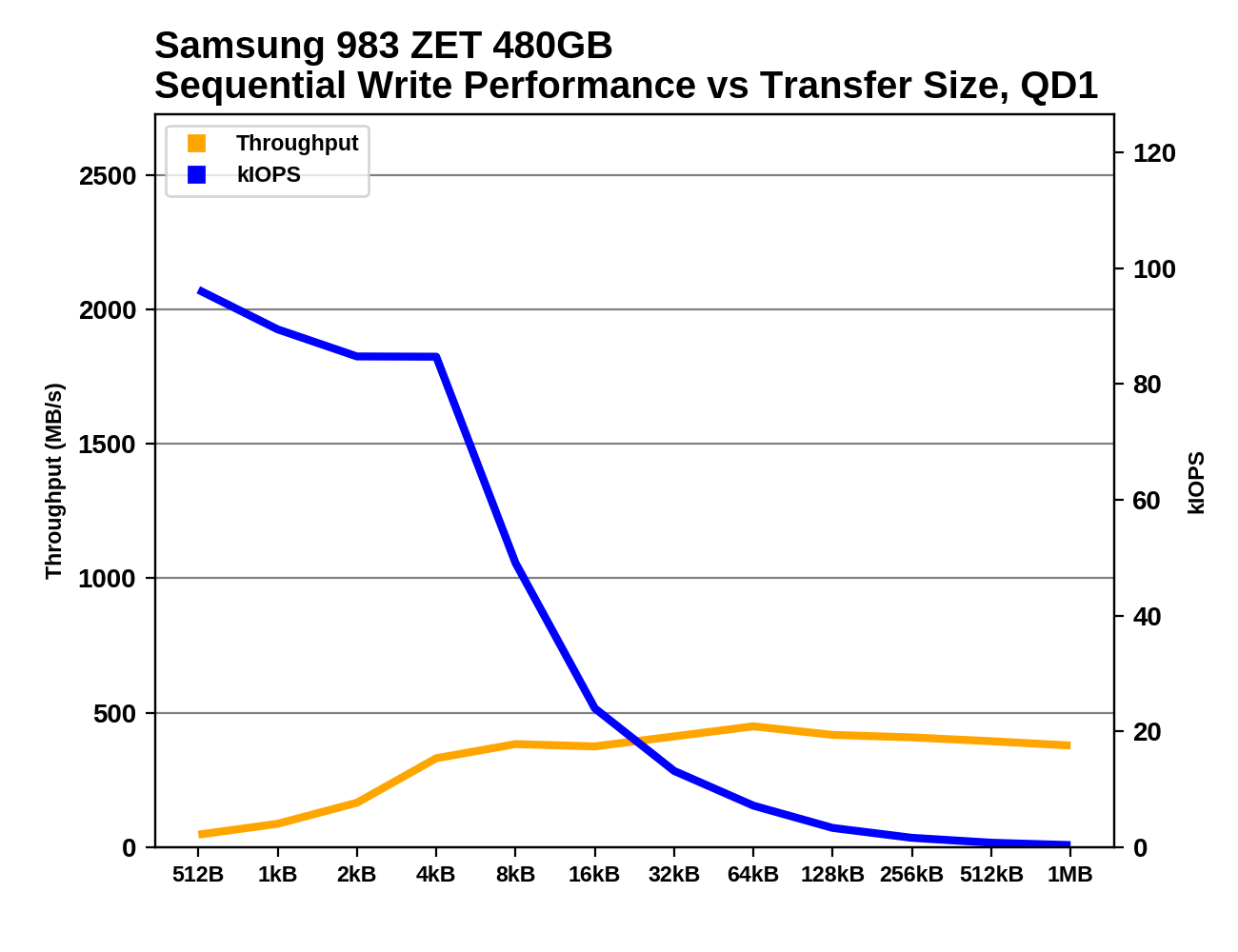 |
|||||||||
For sequential writes, the 983 ZET does not penalize sub-4kB transfers in terms of IOPS, but such small writes cannot deliver much throughput. The 983 ZET is close to full steady-state throughput with 8kB transfers, but doesn't actually peak until the transfers are up to 64kB.










44 Comments
View All Comments
eddman - Tuesday, February 19, 2019 - link
It's certainly better than other flash solutions but this is supposed to compete with optane and yet is unable to beat or match it in use cases that matter.I don't see customers, looking for absolute performance in those use cases, choosing this over optane even at these lower prices. Endurance seems to be lower too.
P.S. I remember comments from people, specially a certain individual, vehemently claiming that SLC can easily compete with 3D xpoint and that companies are simply not bothering with making it happen because the money is in MLC/TLC only.
Kracer - Tuesday, February 19, 2019 - link
Is the Samsung 3D NAND Comparison table right?9x layer nand has the same capacity as 48 layer.
Billy Tallis - Tuesday, February 19, 2019 - link
These days, Samsung is making both 256Gb and 512Gb TLC parts, but the data shown is what they announced for the 256Gb 9xL part. The higher density of the newer generations means the die size is smaller for the same capacity, but I don't have those numbers and don't feel like decapping any of my working drives to measure.Kracer - Wednesday, February 20, 2019 - link
Huh, ok.Thanks for the reply.
Samus - Tuesday, February 19, 2019 - link
You can buy SIX 480GB Enterprise-class eMLC drives with around half the write endurance and slightly less performance for the same price. That means you could double up TWO drives 3x in varying configurations or RAID to have similar endurance.The margins on this thing must be ridiculous. We thought X-point prices were out of this world but this is out of this galaxy. It would be competitive at HALF the price, but the fact is X-point is better and somehow, shockingly, its actually cheaper!?
PeachNCream - Tuesday, February 19, 2019 - link
Why would prices need to be in this galaxy when we're talking about a Samsung Galaxy instead?Sorry, I couldn't resist...I'll leave now.
eastcoast_pete - Tuesday, February 19, 2019 - link
Definitely NOT a consumer drive.@Billy Regarding the Optane drive performance: any information or experience with DIMM format Optane? I believe Intel launched DDR4 slot format compatible Optane modules. How much faster are they than the PCI-E drives?
ksec - Tuesday, February 19, 2019 - link
I don't think any consumer would be interested in these. Would love ServeTheHome doing some DB testing with it. Looking at the price and performance I think that is going to Win a lot of business from Optane. NAND price are dropping as well, so Samsung would have lots of capacity for Shipment.MamiyaOtaru - Tuesday, February 19, 2019 - link
where's ddriver? He was constantly banging on about how terrible "hypetane" is (and how clever he was for coming up with that nickname) and how SLC would kick its ass""no other alternative nonvolatile memory technology is close to being ready to challenge 3D XPoint"
Except for SLC, which was so good it was immediately abandoned once inferior and more profit friendly NAND implementations were available.
A SLC based product coupled with MRAM cache will easily humiliate hypetane in its few strong aspects."
https://www.anandtech.com/show/11953/the-intel-opt...
I am still disappointed by optane, and now I'm disappointed by znand (performance and price). Wish we had some non-volatile memory that was affordable and not trending towards more and more fragility (QLC)
JoeyJoJo123 - Tuesday, February 19, 2019 - link
Looks like I'm not the only one that remembers the absurdity in trying to bring back SLC for common end user machines.The price/GB says it all. It's for enterprise or extreme enthusiasts only, and that's fine, because these deep wallet customers push the industry forward. It's just at the end of the day, if you need the best, you need to pay to get the best. Whining about MLC/TLC/QLC/Optane etc doesn't make the end-user products better.